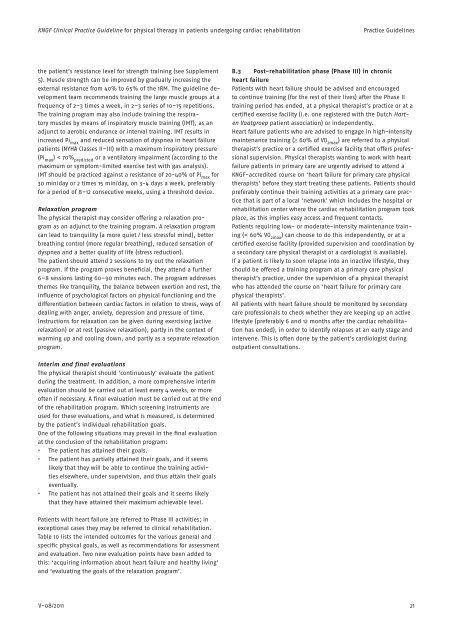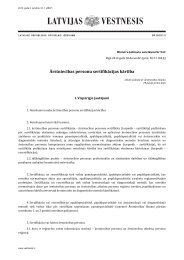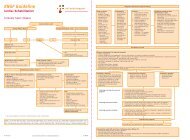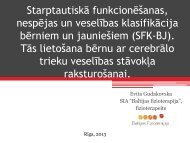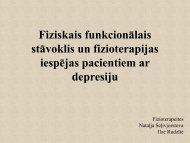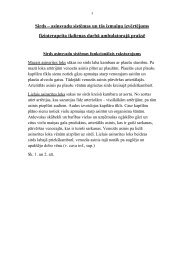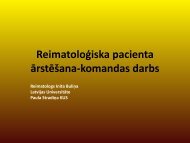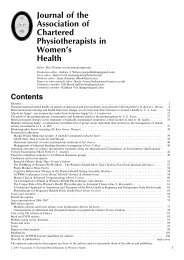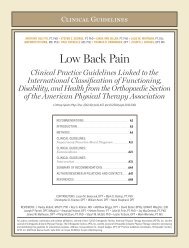KNGF Guideline Cardiac rehabilitation
KNGF Guideline Cardiac rehabilitation
KNGF Guideline Cardiac rehabilitation
Create successful ePaper yourself
Turn your PDF publications into a flip-book with our unique Google optimized e-Paper software.
<strong>KNGF</strong> Clinical Practice <strong>Guideline</strong> for physical therapy in patients undergoing cardiac <strong>rehabilitation</strong><br />
Practice <strong>Guideline</strong>s<br />
the patient’s resistance level for strength training (see Supplement<br />
5). Muscle strength can be improved by gradually increasing the<br />
external resistance from 40% to 65% of the 1RM. The guideline development<br />
team recommends training the large muscle groups at a<br />
frequency of 2–3 times a week, in 2–3 series of 10–15 repetitions.<br />
The training program may also include training the respiratory<br />
muscles by means of inspiratory muscle training (IMT), as an<br />
adjunct to aerobic endurance or interval training. IMT results in<br />
increased Pi max and reduced sensation of dyspnea in heart failure<br />
patients (NYHA Classes II–III) with a maximum inspiratory pressure<br />
(Pi max ) < 70% predicted or a ventilatory impairment (according to the<br />
maximum or symptom-limited exercise test with gas analysis).<br />
IMT should be practiced against a resistance of 20-40% of Pi max for<br />
30 min/day or 2 times 15 min/day, on 3-4 days a week, preferably<br />
for a period of 8–12 consecutive weeks, using a threshold device.<br />
Relaxation program<br />
The physical therapist may consider offering a relaxation program<br />
as an adjunct to the training program. A relaxation program<br />
can lead to tranquility (a more quiet / less stressful mind), better<br />
breathing control (more regular breathing), reduced sensation of<br />
dyspnea and a better quality of life (stress reduction).<br />
The patient should attend 2 sessions to try out the relaxation<br />
program. If the program proves beneficial, they attend a further<br />
6–8 sessions lasting 60–90 minutes each. The program addresses<br />
themes like tranquility, the balance between exertion and rest, the<br />
influence of psychological factors on physical functioning and the<br />
differentiation between cardiac factors in relation to stress, ways of<br />
dealing with anger, anxiety, depression and pressure of time.<br />
Instructions for relaxation can be given during exercising (active<br />
relaxation) or at rest (passive relaxation), partly in the context of<br />
warming up and cooling down, and partly as a separate relaxation<br />
program.<br />
B.3 Post-<strong>rehabilitation</strong> phase (Phase III) in chronic<br />
heart failure<br />
Patients with heart failure should be advised and encouraged<br />
to continue training (for the rest of their lives) after the Phase II<br />
training period has ended, at a physical therapist’s practice or at a<br />
certified exercise facility (i.e. one registered with the Dutch Harten<br />
Vaatgroep patient association) or independently.<br />
Heart failure patients who are advised to engage in high-intensity<br />
maintenance training (≥ 60% of VO 2max ) are referred to a physical<br />
therapist’s practice or a certified exercise facility that offers professional<br />
supervision. Physical therapists wanting to work with heart<br />
failure patients in primary care are urgently advised to attend a<br />
<strong>KNGF</strong>-accredited course on ‘heart failure for primary care physical<br />
therapists’ before they start treating these patients. Patients should<br />
preferably continue their training activities at a primary care practice<br />
that is part of a local ‘network’ which includes the hospital or<br />
<strong>rehabilitation</strong> center where the cardiac <strong>rehabilitation</strong> program took<br />
place, as this implies easy access and frequent contacts.<br />
Patients requiring low- or moderate-intensity maintenance training<br />
(< 60% VO 2max ) can choose to do this independently, or at a<br />
certified exercise facility (provided supervision and coordination by<br />
a secondary care physical therapist or a cardiologist is available).<br />
If a patient is likely to soon relapse into an inactive lifestyle, they<br />
should be offered a training program at a primary care physical<br />
therapist’s practice, under the supervision of a physical therapist<br />
who has attended the course on ‘heart failure for primary care<br />
physical therapists’.<br />
All patients with heart failure should be monitored by secondary<br />
care professionals to check whether they are keeping up an active<br />
lifestyle (preferably 6 and 12 months after the cardiac <strong>rehabilitation</strong><br />
has ended), in order to identify relapses at an early stage and<br />
intervene. This is often done by the patient’s cardiologist during<br />
outpatient consultations.<br />
Interim and final evaluations<br />
The physical therapist should ‘continuously’ evaluate the patient<br />
during the treatment. In addition, a more comprehensive interim<br />
evaluation should be carried out at least every 4 weeks, or more<br />
often if necessary. A final evaluation must be carried out at the end<br />
of the <strong>rehabilitation</strong> program. Which screening instruments are<br />
used for these evaluations, and what is measured, is determined<br />
by the patient’s individual <strong>rehabilitation</strong> goals.<br />
One of the following situations may prevail in the final evaluation<br />
at the conclusion of the <strong>rehabilitation</strong> program:<br />
• The patient has attained their goals.<br />
• The patient has partially attained their goals, and it seems<br />
likely that they will be able to continue the training activities<br />
elsewhere, under supervision, and thus attain their goals<br />
eventually.<br />
• The patient has not attained their goals and it seems likely<br />
that they have attained their maximum achievable level.<br />
Patients with heart failure are referred to Phase III activities; in<br />
exceptional cases they may be referred to clinical <strong>rehabilitation</strong>.<br />
Table 10 lists the intended outcomes for the various general and<br />
specific physical goals, as well as recommendations for assessment<br />
and evaluation. Two new evaluation points have been added to<br />
this: ‘acquiring information about heart failure and healthy living’<br />
and ‘evaluating the goals of the relaxation program’.<br />
V-08/2011<br />
21


